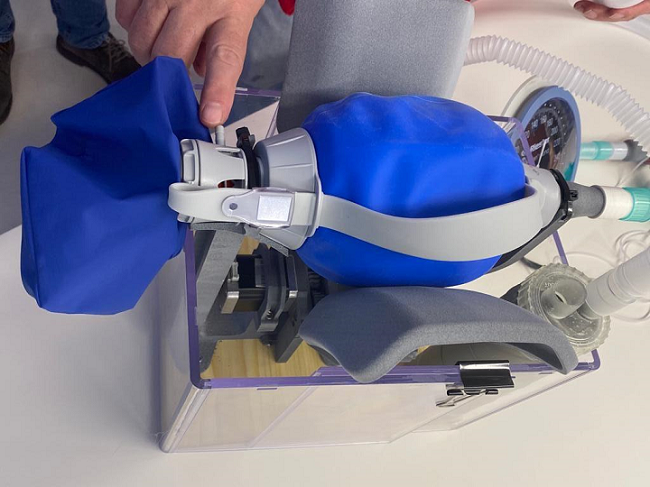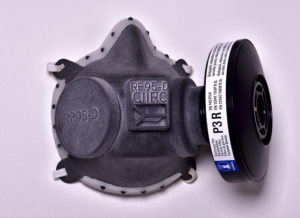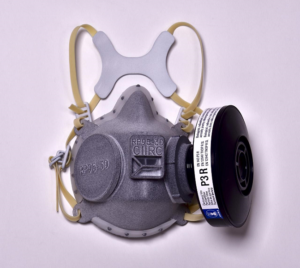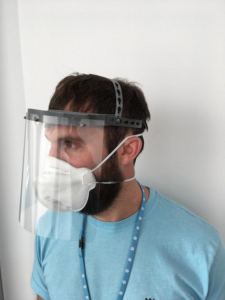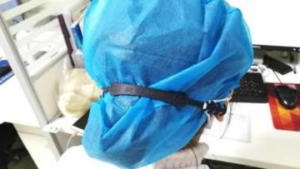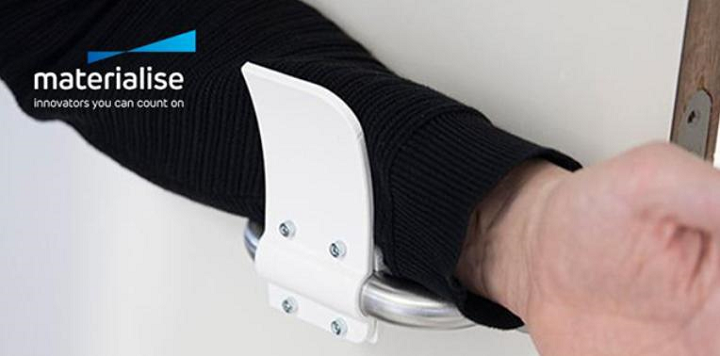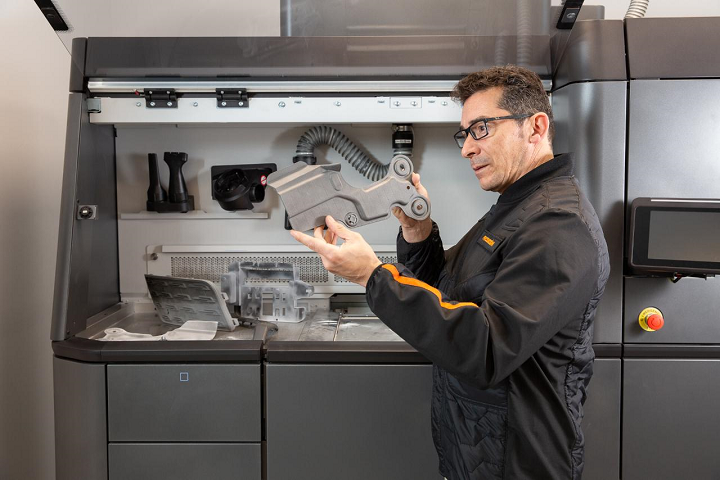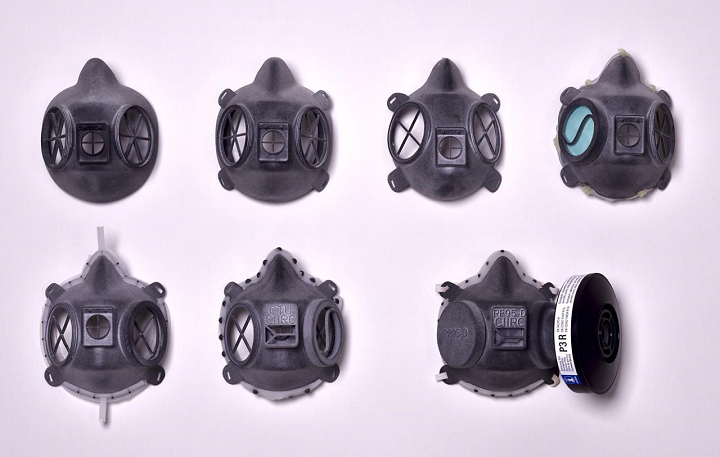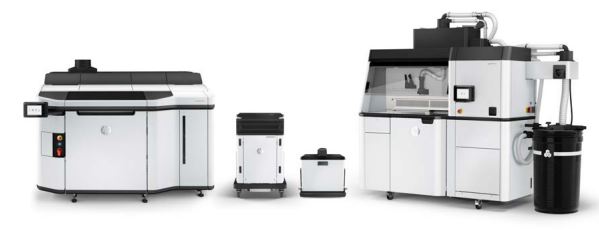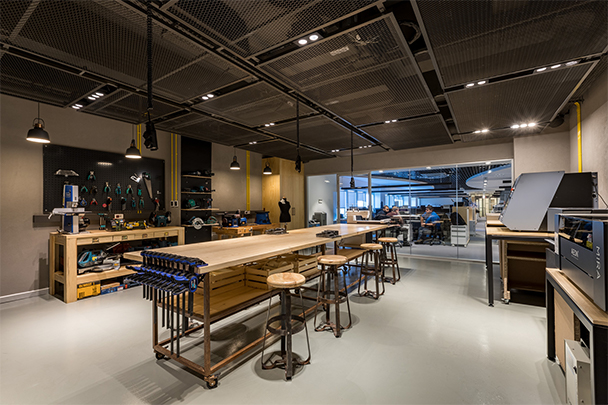DyeMansion launches 17 vibrant new colors for post-processing 3D printed HP MJF parts
HP’s Partner Network Teams Up to Battle COVID-19 with Simple Designs & 3D Printed Innovations
Normally, this is the time of year when we’re fielding a constant flood of press releases, firming up travel plans, and starting to set interview schedules for the annual 3D printing extravaganza that is RAPID + TCT. But SARS-CoV-2, otherwise known as COVID-19 or the coronavirus, has changed all that. On top of nearly all major additive manufacturing shows in the near future (and the Tokyo Olympics) being canceled, the pandemic is wreaking havoc elsewhere as well.
According to the World Health Organization, there are currently close to 400,000 cases of the disease around the world, with that number rising every day, and we’ve all added the phrase “social distancing” to our vocabulary. On a personal note, I’m a frequent theatre volunteer, and the shows I was working on have either been postponed or canceled. Last night, I delivered groceries (though not toilet paper) to my 94-year-old grandparents since they’re not supposed to leave the house, waved to my mother from six feet away, and I’ve participated in numerous Zoom conferences and FaceTime calls with friends over the past week, since Ohio is under a “stay at home” order.
But, as the above quote from beloved American TV personality Fred Rogers says, you can always find people who are helping during the hard times. HP Inc. is one of those helpers: the company, along with its digital manufacturing community, is mobilizing its 3D printing experience, technology, production capacity, and teams to help find solutions for the worldwide battle against COVID-19.
“HP and our digital manufacturing partners are working non-stop in the battle against this unprecedented virus,” stated HP’s President and CEO Enrique Lores. “We are collaborating across borders and industries to identify the parts most in need, validate the designs, and begin 3D printing them. Our deepest appreciation goes to our employees, partners, customers, and members of our community for their tireless efforts to support the medical professionals making a difference on the front lines.”
HP’s worldwide network of digital manufacturing and production partners has stepped up to the plate to create and deliver 3D printed critical parts during this pandemic to help support the global health community, and more than 1,000 parts have been delivered to local hospitals already. The company’s 3D R&D centers in Washington, Oregon, California, and Spain are banding together, working with partners all around the world to ramp up production of these parts in order to help the healthcare sector meet the urgent needs of its many patients, and contain the spread of COVID-19, through 3D printing.
Because HP’s network of manufacturing partners is global, these 3D printed parts should be available to hospitals in any region in the world. The company is working with industry, health, and government agencies to make sure that the approach is effective and synchronized, and its partners are making many of their validated 3D design files available for download free of charge here. The available designs consist of parts that don’t require complex assembly, so that production can keep up its accelerated pace.
There are several important applications that have already been finalized for industrial 3D printing, such as respirator parts and nasal swabs. Another is a face shield, which is one of the personal protection items in high demand at the moment. A critical component of these shields are 3D printable brackets that help ensure a comfortable fit.
Hospital staff are often required to wear face masks for extended periods of time now. A 3D printed mask adjuster features a clasp that helps provide the wearer with some relief from ear pain caused by wearing their masks for so long.
One of the most germ-infested items in any hospital, home, or workplace is the door handle – just think how many different people have touched it in a 24-hour period! On second thought, maybe don’t think about it. But a 3D printed adapter makes it possible to easily open doors with your elbows: a hands-free option that obviously keeps things much cleaner.
Plenty of other 3D printed applications to help contain COVID-19 are currently in the testing and validation phase, and production for these should start in the coming days and weeks. One such example is the FFP3 face mask, which helps protect medical providers as they treat a higher volume of patients. HP is currently validating multiple hospital-grade 3D printable face masks, and they should be available soon.
A simplified design that requires 3D printed parts for a field ventilator is also being validated. The mechanical bag valve mask (BVM) was designed to provide short-term emergency ventilation to patients with COVID-19, and while it’s definitely an important application, the design makes the device simple yet strong, which helps speed up the production and assembly process.
3D designers who are interested in helping fight COVID-19 can visit this HP website to contribute ideas and applications. If you, or someone you know, would like to order parts that can help in the pandemic battle, or require support with application development, requests can be submitted here. Be safe, be smart, and stay healthy!
Discuss this news and other 3D printing topics at 3DPrintBoard.com or share your thoughts in the Facebook comments below.
(Images: HP, unless otherwise noted)
The post HP’s Partner Network Teams Up to Battle COVID-19 with Simple Designs & 3D Printed Innovations appeared first on 3DPrint.com | The Voice of 3D Printing / Additive Manufacturing.
Airbus Subsidiary Uses Full-Color Multi Jet Fusion for Maintenance Tooling
Among the most exciting aspects of HP’s Multi Jet Fusion (MJF) technology when initially unveiled was the ability to 3D print functional objects in a full range of color. Though it took a couple of years for it to happen, that capability finally hit the market in 2018 with the release of the HP Jet Fusion 300/500 Color 3D Printer range. Now we are beginning to see the applications that a broad spectrum of hues has in practice. Airbus services company Satair used the technology to 3D print a series of tools for its maintenance operations.
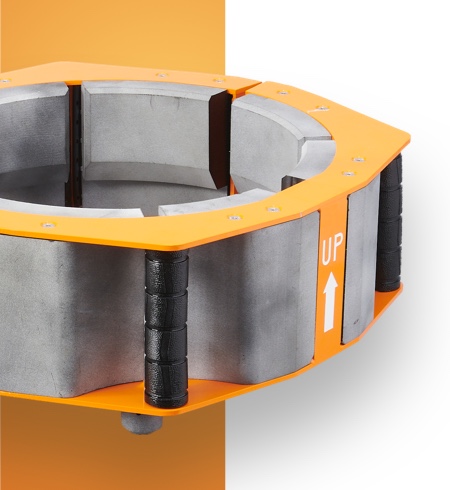
Used to gag the main landing gears on the A380, the GAGS tool pads were redesigned to improve the strength-to-weight ratio, resulting in 60 percent mass reduction. Image courtesy of HP.
Satair turned to service bureau Fast Radius with the ultimate goal of to speed up aircraft repair with the use of 3D printed tools. As a member of HP’s Digital Manufacturing Network, Fast Radius leveraged MJF to print tools for the company. In particular, the color printing capabilities of the Jet Fusion 580 Color system were utilized to 3D print bright red and orange tools in order to improve job safety and ensure that tools were not misplaced after use. The tools were also optimized to reduce total part count, enhance robustness and integrate new functions.
One particularly unique feature about the company is the fact it has a production hub on-site at the UPS Worldport facility in Louisville, Kentucky, allowing it to potentially ship parts at greater speeds than other service providers.

This pintle bearing alignment tool is used to bear in the rear spar prior to installing it during the installation of the main landing gear installation. Assembly was reduced from four parts to two. Image courtesy of HP.
Three new tools were redesigned and printed by HP and Fast Radius for Satair: GAGS tool pads, pintle bearing alignment tools, and flap zero locking tools. MJF was chosen in part for the ability to 3D print durable parts with the mechanical properties necessary for harsh aircraft repair environments. Specifically, HP 3D High Reusability PA 12 was chosen due to its chemical resistance to oils, grease, aliphatic hydrocarbons and alkalies.
3D printing the parts also sped up design time, as multiple iterations could be produced at once within a single build. The use of color also allowed for the communication of information in unique ways, such as 3D printing part numbers, serial numbers and scannable QR codes directly onto the tool.
Whereas Satair previously waited weeks for new tools to be manufactured, this project saw Fast Radius print, inspect, package and ship two tools in less than 48 hours. This was enabled in part by Fast Radius’s logistics partnership with UPS, with which it sent the items from Chicago to Hamburg, Germany.
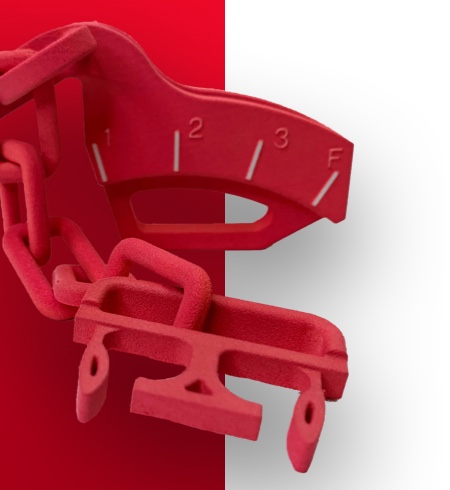
This flap zero locking tool is used to lock flaps in the A320 cockpit. The assembly was reduced from six parts to two and resulted in a lead time reduction of 50 percent. Image courtesy of HP.
The use of 3D printing by Satair is just another notch in Airbus’s belt, as the aerospace giant deploys AM all across its business to the point that it is probably not necessary to recount all of the ways it is being used, but we can highlight the myriad parts printed for the A350 XWB, as well as the work of Premium AEROTEC and APWorks.
As for Fast Radius, this is another interesting customer from the service bureau, which is fond of emerging AM technologies. For instance, the company also used Carbon’s Digital Light Synthesis to print parts for Steelcase’s office chair. Outside of 3D printing, Fast Radius offers a number of other manufacturing services, including CNC machining and injection molding. With the Fast Radius Virtual Warehouse, the company is hoping to implement the concept of digital inventory, in which digital files replace physical stock, with goods manufactured on-demand.
As with 3D printing itself, it will take some time for designers and engineers to fully grasp the potential of producing parts in full color. The ability to use bright pigments for safety purposes and to embed QR codes is just the beginning. HP previously demonstrated the use of colors to exhibit the level of wear on a part, so that, as it is worn down, it shows new colors that can be more easily quantified. Augmented reality applications could also be developed based on embedded symbols in a part. In the near future, we may see even more interesting uses of full color printing of end parts.
The post Airbus Subsidiary Uses Full-Color Multi Jet Fusion for Maintenance Tooling appeared first on 3DPrint.com | The Voice of 3D Printing / Additive Manufacturing.
Triple Eight Race Engineering customizes race wheel with HP MJF 3D printing
Oakley selects HP 3D printing as prototyping partner for sports equipment
Materialise becomes first to offer BASF TPU material for HP Multi Jet Fusion 3D printing
Interview with Elisabeth Moreno on HP and 3D Printing in Africa
Elisabeth Moreno, the Vice President and Managing Director Africa at HP Technology, talks to us about HP’s role in 3D printing in Africa, as well as the company’s influence in promoting the technology.
Elisabeth Moreno
Can you tell us about your involvement in 3D printing and additive manufacturing?
HP’s vision in 3D printing is to change how the world designs and manufactures and to lead in the Fourth Industrial Revolution.
The combination of our IP, an expanded platform and a portfolio of products, and a continuously growing ecosystem of partners makes us a leader in 3D printing. We have alliances with organizations and companies including BASF, Materialise, and Siemens; and with industry leaders like Jaguar Land Rover, Vestas and more, all of which embrace HP 3D printing solutions.
Just a few weeks ago we announced a new 3D Printing and Digital Manufacturing Center of Excellence in Barcelona, Spain, which brings together hundreds of the world’s leading additive manufacturing experts in more than 150,000 square feet of cutting-edge innovation space.
In Africa, we know from Albright Stonebridge Group that 3D printing technology is expected to become a $4.5 billion industry in emerging markets by 2020. The technology is already being used today in various industries throughout the continent, including medical, agricultural, infrastructural and manufacturing applications.
What special projects or works have you done or are currently developing in the 3D printing landscape?
Globally, our work in 3D printing is quite vast. HP 3D printing technology is used for everything from prototyping to mass production. A few examples include:
-
HP LIFE Centers throughout Africa are one area we’re exposing youth and women to disruptive technologies like 3D printing. Through these LIFE Centers, HP is giving entrepreneurs in Africa the tools and education needed for jobs of the future, and no doubt 3D printing will play a huge role in this transition.
-
Recently we announced our work in South Africa with Tarsus Distribution and Solid Edge Technology. HP Multi Jet Fusion technology will be available through Tarsus’s and Solid Edge’s networks, particularly benefiting the automotive, industrial, healthcare, consumer goods markets.
-
Globally, we recently announced an expanded collaboration with customer SmileDirectClub to revolutionize the way that millions of people can achieve a straighter smile. By leveraging HP Jet Fusion 3D printing, SmileDirectClub will produce 50,000 unique mouth molds a day, and nearly 20 million individual 3D printed mouth molds in the next 12 months.
HP Multi Jet Fusion 3D printers family
What can you say about Women in 3D Printing and their influence or contribution to the technology?
3D printing can help make life better for everyone, everywhere. But like all other industries, if the people shaping the technology and the way it is used do not reflect society, we will be let down.
As an African woman, this topic is near and dear to my heart. We must ensure this next industrial revolution is inclusive and powered by the diversity of thought. HP prioritizes diversity in all that we do, and our 3D printing business is no exception.
How do you see 3D Printing and Additive manufacturing’s growth and development?
Although 3D printing technology isn’t necessarily new, the scope of its potential has taken off in just a matter of years. 3D printing is already being used in major industries like automotive, healthcare and heavy industry, just to name a few.
Here in Africa, we’re working closely with leaders like Tarsus Distribution and SeTech to bring 3D printing to South Africa.
SeTech’ s demo center, just outside of Johannesburg, is fully functional with an HP Multi Jet Fusion 4200 production unit and will enable customers to do benchmarking for a variety of verticals mentioned above.
Working with SeTech and Tarsus, we are spreading the knowledge about the possibilities 3D printing can offer to the African landscape, provide training sessions with experts and teaching customers about the technology.
HP Jet fusion 3D printer
Around the world, we also see 3D printing playing a huge role in education and skills provision for future jobs. For example, we’re beginning to see universities adopt 3D technology to prepare the future workforce for the Fourth Industrial Revolution.
Model printed with HP Multi Jet Fusion
Two universities in Turkey have recently installed HP Multi Jet Fusion 3D printers to drive education and R&D purposes. Celal Bayar University has installed Multi Jet Fusion 3D printers in their Technology Centre, which they are using for both education and R&D purposes.
And, Istanbul Technical University, a highly respected university dedicated to the field of technology, has installed MJF 3D printers in their incubation center, ITÜMagnet, giving startups access to 3D printing technology.
ITU Magnet Incubation Center
What is your current organization’s position on 3D Printing and Additive manufacturing?
No doubt, there is a digital revolution happening in all areas of design, distribution, sustainability, and the entirety of the end-to-end manufacturing process. This revolution is enabling companies to do great things – innovate faster, leverage flexible manufacturing, reinvent their supply chains, create new markets, and produce new applications in new ways that were previously impossible.
And we’re just getting started. The World Economic Forum (WEF) recently estimated the value of digital transformations in the Fourth Industrial Revolution to be as much as $100 trillion over the next 10 years.
Parts printed at Incubation centre using HP Multi Jet Fusion
The post Interview with Elisabeth Moreno on HP and 3D Printing in Africa appeared first on 3DPrint.com | The Voice of 3D Printing / Additive Manufacturing.
Smile Direct Club Partners With HP To Make 50,000 3D Printed Molds per Day
Invisalign is one of the 3D printing manufacturing success stories. The clear aligners company has changed how you can straighten your teeth. By using CT scan based unique 3D printed molds to make a series of aligners for you as your teeth change Invisalign has made getting a more movie-like smile easier. The firm has 3D printed millions of stereolithography molds over the years and built out the segment to a well-known brand. Recently their success has attracted a number of competitors, chief amongst them SmileDirectClub.
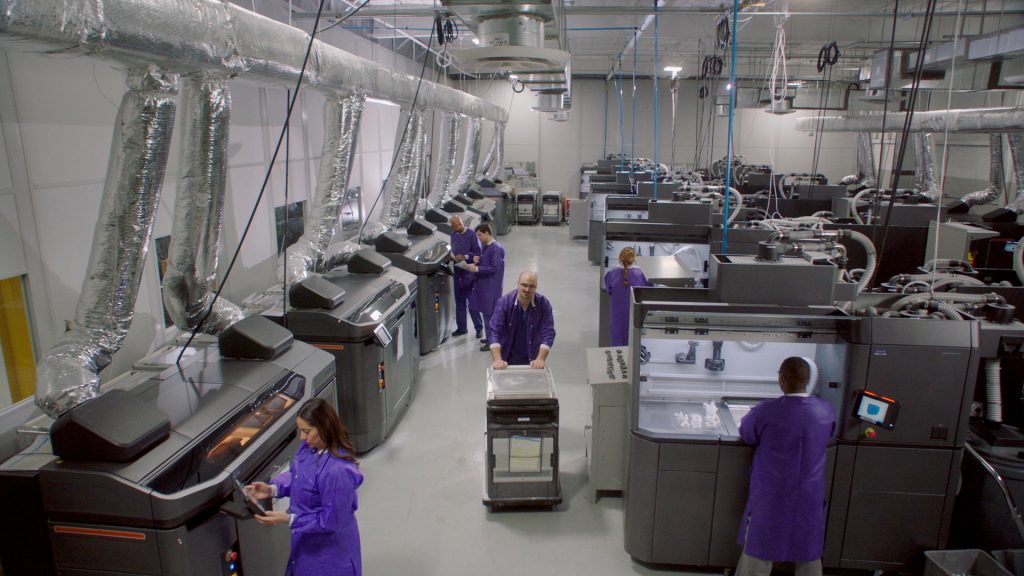
SmileDirectClub is pursuing an aggressive growth strategy in deploying direct to consumer marketing to become the number two purveyor of smiles worldwide. For molding SLA (stereolithography) is difficult to beat. Parts come out at the smoothest quality for 3D printing with high levels of detail. There is some finishing always with this technology and the resins are very expensive but on the whole, whether it be for jewelry lost wax casting, dental molds or things like aligners the technology is tried and true. Tens of millions of SLA parts have been used in indirect manufacturing and for this application it (and the related DLP technology) is the most obvious technology to try. Its the default by a wide margin and most wouldn’t veer away from it.
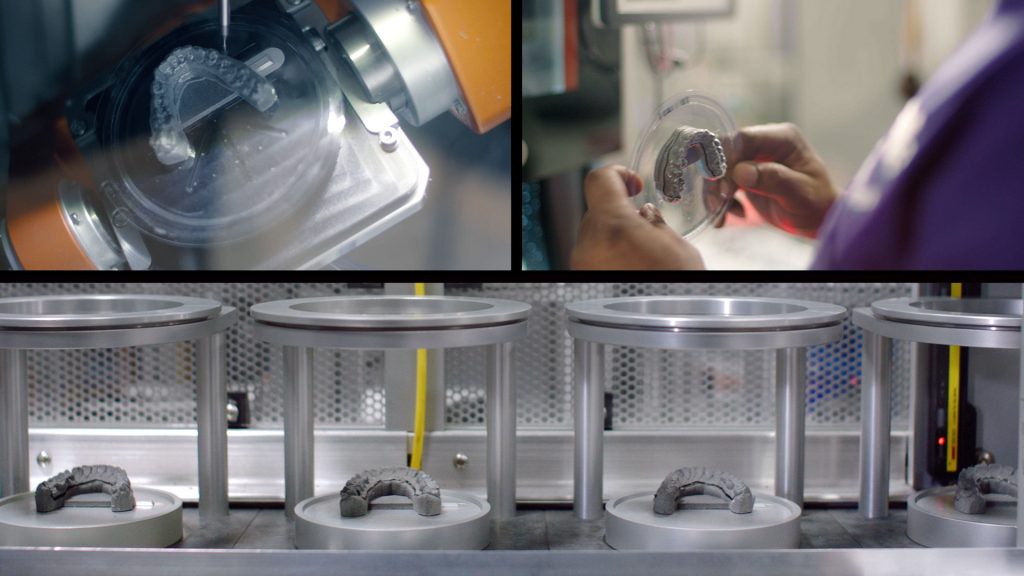
The smile hunters at SmileDirectClub tried a different route however. Smile Direct Club now uses HP’s Multi Jet Fusion 3D Printing technology to produce molds. I’d like to personally extend a heartfelt hug and high five to the HP sales/business development person that made this happen. You dear Sir or Madame are amazing! You rock. This is an achievement. You took a bag of powdery parts and talked these people out of the slippery smooth SLA way. Salespeople could just be at the right firm at the right time. Like a cruise ship passenger, a salesperson could just have boarded the right cruise at the right time and the ship, crew, captain all could have fallen in place to make their bonus possible quarter after quarter. Or the best salesperson ever could have simply gotten on the wrong pirate ship. Sometimes however salespeople make a real difference and break into new markets and applications. This is one of those times. Amazing job and indeed a great day for HP.
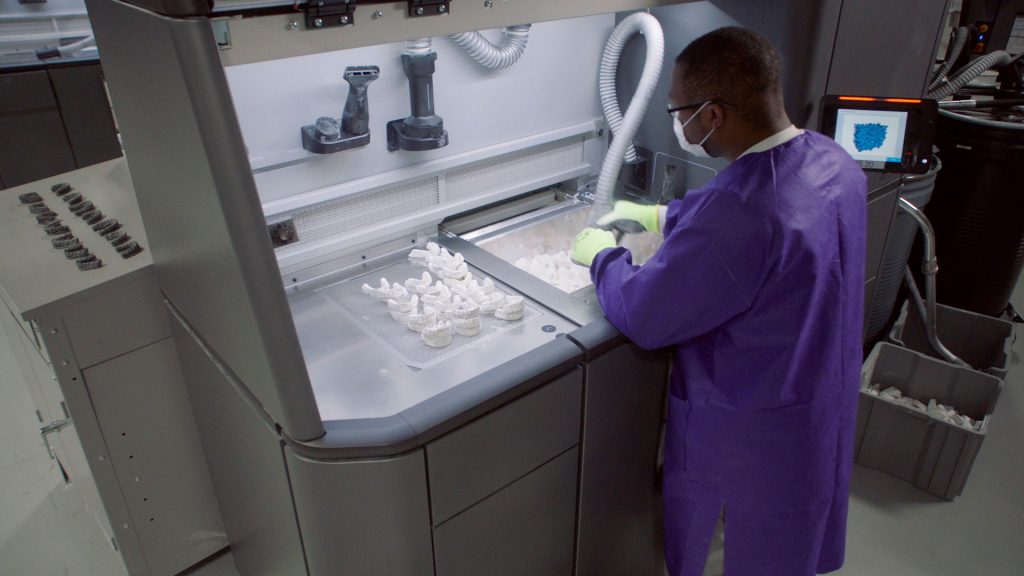
SmileDirectClub will use 49 HP Jet Fusion 3D printers for manufacturing 24/7. The printers will make more than 50,000 molds a day. This makes SmileDirectClub one of the largest users of HP systems worldwide. The company is on track to make 20 million 3D printed molds over the next 12 months.
In one fell swoop HP has gone from, looks cute might delete later, to a viable option for manufacturing companies. If you can make positives for mold applications cost effectively then a lot of other applications will be possible also. At the same time, the partners will turn the molds and unused powder into pellets for injection molding applications. All companies should do this. This is great for people that used to hang out with Sting and the world in general as well. Its also quite the brilliant marketing move because the competing SLA molds are thermosets and can’t be recycled. This representa a Big day for HP and a sends a strong signal for the validation of the technology. Well done all around.
3D Printing News Briefs: May 16, 2019
We’ve got plenty of business news for you in today’s 3D Printing News Briefs, starting with Additive Manufacturing Technologies’ impressive growth as of late. ExOne has announced a collaboration with Oak Ridge National Laboratory, and DigiFabster has announced several updates to its platform. Moving on to new product launches, Shining3D has a new industrial metrology system, and peel 3d introduced a new affordable 3D scanner.
Additive Manufacturing Technologies Showing Rapid Growth
UK-based Additive Manufacturing Technologies (AMT) was founded in 2017 and is now emerging from semi-stealth mode and into full commercial production with its automated post-processing and finishing solutions for 3D printed parts. The company is showing rapid growth forecasts, and has been opening new US facilities, announcing partnerships, and hiring important personnel to help with its mission of providing the industry with industrial AM post-processing. AMT has made two important strategic additions to its Global Innovation Centre in Sheffield, appointing David Manley as Non-Executive Chairman and hiring Gavin Minton as the Aftersales and Customer Experience Manager.
“These are indeed exciting times at AMT as we aggressively market and sell our PostPro3D post-processing systems for AM parts having moved from the semi-stealth mode we have been operating in for a couple of years. We have been growing rapidly, but now we are moving to the next level — with our technology capabilities, our facilities and our brilliant team. We are really excited to welcome David and Gavin to AMT — they will be fundamental to our continued growth strategy,” said Joseph Crabtree, CEO at AMT.
“The post-processing step has long been the Achilles heel for AM as it moves to being a true mass manufacturing technology, and we are proud to offer our fully automated solution, which is already revolutionising the ways in which manufacturers integrate AM as a mass production tool. AMT is working in partnership with numerous OEMs, vendors and material suppliers to take the pain out of post-processing with an intelligent and collaborative approach, and we are scaling up production globally in order to share the progress we have made with our post-processing solutions. David and Gavin will join our team to provide key support in this mission.”
ExOne Announces Collaboration with Oak Ridge National Laboratory
 The ExOne Company, which manufactures 3D printers and provides 3D printing services to industrial customers, is collaborating with Oak Ridge National Laboratory (ORNL) to continue advancements in binder jet 3D printing technology. Binder jetting is important because it offers lower operating costs, and maintains higher levels of productivity, than many other AM technologies, and ExOne is an industry leader in non-polymer binder jet 3D printing. Its collaboration with ORNL is targeted initially on developing technology for new binder jet systems, leveraging ORNL’s instrumentation and advanced data analysis methodologies, as well as the Department of Energy’s Manufacturing Demonstration Facility (MDF) at ORNL, in order to optimize chemistry and process parameters for its sand and metal systems.
The ExOne Company, which manufactures 3D printers and provides 3D printing services to industrial customers, is collaborating with Oak Ridge National Laboratory (ORNL) to continue advancements in binder jet 3D printing technology. Binder jetting is important because it offers lower operating costs, and maintains higher levels of productivity, than many other AM technologies, and ExOne is an industry leader in non-polymer binder jet 3D printing. Its collaboration with ORNL is targeted initially on developing technology for new binder jet systems, leveraging ORNL’s instrumentation and advanced data analysis methodologies, as well as the Department of Energy’s Manufacturing Demonstration Facility (MDF) at ORNL, in order to optimize chemistry and process parameters for its sand and metal systems.
“By collaborating with a world-class lab like Oak Ridge National Laboratory, we accelerate ExOne’s binder jetting technology capabilities,” said Rick Lucas, ExOne’s Chief Technology Officer. “We believe these collaborative efforts will effectively and efficiently result in the establishment of new materials, binders and process developments, retaining our significant edge over competitors and other technologies in the industrial manufacturing space.”
DigiFabster Announces Platform Updates
 3D printing software and services provider DigiFabster, which uses its software-as-a-service (SaaS) platform to help companies easily automate and streamline certain business processes, announced that it had made several important enhancements to its platform this spring that will benefit many different types of users, including 3D printing service bureaus. The company has many customers who use HP’s Multi Jet Fusion technology, which accepts the 3MF file format, and DigiFabster’s platform now supports 3MF direct uploads through its web-based widget.
3D printing software and services provider DigiFabster, which uses its software-as-a-service (SaaS) platform to help companies easily automate and streamline certain business processes, announced that it had made several important enhancements to its platform this spring that will benefit many different types of users, including 3D printing service bureaus. The company has many customers who use HP’s Multi Jet Fusion technology, which accepts the 3MF file format, and DigiFabster’s platform now supports 3MF direct uploads through its web-based widget.
DigiFabster also enabled a new feature so that customers can accept purchase orders as a form of payment, and modified the code for its Floating button installation so that it can adapt to different screen widths. Another new capability makes it possible for CNC users, like machine shops, to easily change their pricing based on how complex the machine work is, and the DigiFabster system was also updated to automatically check for wall thickness, so that the files customers receive are ready.
SHINING 3D Launched New Metrology Products
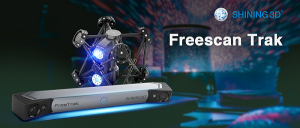 Chinese 3D printing and digitizing company SHINING 3D recently attended the international Control trade fair for quality assurance, and released its latest industrial metrology solution at the event. Three products make up the portable system – the FreeTrak optical scanner, Freescan Trak 3D scanner, and FreeTrak Probe – which work separately and together to offer a comprehensive industrial scale measurement solution.
Chinese 3D printing and digitizing company SHINING 3D recently attended the international Control trade fair for quality assurance, and released its latest industrial metrology solution at the event. Three products make up the portable system – the FreeTrak optical scanner, Freescan Trak 3D scanner, and FreeTrak Probe – which work separately and together to offer a comprehensive industrial scale measurement solution.
The versatile FreeTrak system of the wireless solution can capture the scanner structure’s spatial position in real time, and also allows the user to move the part, or tracker, during measurement without the results being compromised, which makes it perfect for use in unstable environments. The FreeTrak Probe, a portable CMM probing system created for use in industrial environments, is not “susceptible to environmental influences” like position changes and vibration, and can be used to generate highly accurate data even in challenging places. The FreeTrak system is now being integrated into SHINING 3D’s metrology and industrial solution ecosystem.
peel 3d Introduces Affordable 3D Scanner
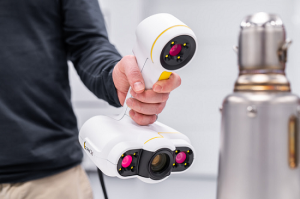 Canadian 3D scanner developer peel 3d is on a mission to provide universal access to affordable, professional-grade 3D scanning technology. Located in Québec, the peel 3d team just launched the peel 2, a brand new variant of its peel 1 scanner that has three cameras instead of just one, for maximum accuracy, resolution, and realism. Powered by Creaform technology like its predecessor, the easy to use peel 2’s integrated color-capture functionality allows users to archive objects in high definition, as well as in their original colors, and monitor the accuracy and progress of the surface coloring. The new peel 2 also features new and improved peel 2.0 software with more functionalities, in addition to a system that uses a scanned object’s texture to improve its ability of positioning itself accurately in space.
Canadian 3D scanner developer peel 3d is on a mission to provide universal access to affordable, professional-grade 3D scanning technology. Located in Québec, the peel 3d team just launched the peel 2, a brand new variant of its peel 1 scanner that has three cameras instead of just one, for maximum accuracy, resolution, and realism. Powered by Creaform technology like its predecessor, the easy to use peel 2’s integrated color-capture functionality allows users to archive objects in high definition, as well as in their original colors, and monitor the accuracy and progress of the surface coloring. The new peel 2 also features new and improved peel 2.0 software with more functionalities, in addition to a system that uses a scanned object’s texture to improve its ability of positioning itself accurately in space.
“peel 2 pushes back all technical boundaries and redefines the concept of affordable 3D scanners,” stated François Leclerc, the head of the peel 3d initiative. “It will appeal as much to artists wishing to switch over to digital as it will to medical professionals wanting to scan the human body or mechanics working with existing components. It is by far the most comprehensive entry-level scanner on the market.”
The peel 2 is available for purchase online from peel 3d and select retailers for $7,490.
Discuss these stories and other 3D printing topics at 3DPrintBoard.com or share your thoughts in the Facebook comments below.

